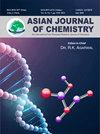Enhanced Photocatalytic Methylene Blue Degradation and Chromium(VI) Photoreduction under Sunlight by Fe3O4@rGO@CeO2/Nd2O3 as Magnetic Recyclable Photocatalyst
Q4 Chemistry
引用次数: 0
Abstract
A significant global concern is in the easy separation, recyclability and reusability of photocatalysts in industrial wastewater treatment applications. Therefore, in this study, the synthesis of magnetically separatable Fe3O4@rGO@CeO2/Nd2O3 photocatalyst using a one-step solvothermal method is reported, which overcomes all these challenges. A binary lanthanide oxides CeO2/Nd2O3 anchored on rGO-wrapped Fe3O4 core-shell magnetic nanoparticles. The synthesized magnetic photocatalyst nanocomposite has been characterized using XRD, FESEM, EDX, HRTEM, TGA-DTA-DSC, VSM, FTIR and UV-visible spectrophotometer. In this work, the Fe3O4 synthesized by solvothermal technique achieved the highest saturation magnetization (MS), 101.84 emu/g. The results showed that Fe3O4@rGO@CeO2/Nd2O3 photocatalyst had more excellent stability up to 880 ºC confirmed by TGA-DTA-DSC analysis and efficient potential for the degradation of methylene blue by photo-Fenton reaction and reduction of Cr(VI) in formic acid under sunlight. The prepared photocatalyst efficiently degrades 98% of methylene blue in 50 min at neutral pH and quick photoreduction of Cr(VI) of 99% takes place within 40 min. After six cycles, the repeatability of the photocatalytic activity exhibited just a slight reduction in catalytic efficiency for degradation of methylene blue and photoreduction of Cr(VI).作为磁性可回收光催化剂的 Fe3O4@rGO@CeO2/Nd2O3 在阳光下增强了光催化降解亚甲基蓝和光还原铬(VI)的能力
光催化剂在工业废水处理应用中的易分离性、可回收性和可再利用性是全球关注的一个重要问题。因此,本研究采用一步溶热法合成了可磁性分离的 Fe3O4@rGO@CeO2/Nd2O3光催化剂,克服了所有这些难题。在 rGO 包裹的 Fe3O4 核壳磁性纳米粒子上锚定了二元镧系氧化物 CeO2/Nd2O3。利用 XRD、FESEM、EDX、HRTEM、TGA-DTA-DSC、VSM、FTIR 和 UV-visible 分光光度计对合成的磁性光催化剂纳米复合材料进行了表征。在这项工作中,通过溶热技术合成的 Fe3O4 达到了最高的饱和磁化率(MS),为 101.84 emu/g。结果表明,经 TGA-DTA-DSC 分析证实,Fe3O4@rGO@CeO2/Nd2O3 光催化剂在高达 880 ºC 的温度下具有更优异的稳定性,并具有在阳光下通过光-芬顿反应降解亚甲基蓝和还原甲酸中六价铬的高效潜力。所制备的光催化剂在中性 pH 条件下,50 分钟内可有效降解 98% 的亚甲基蓝,40 分钟内可快速光还原 99% 的六价铬。经过六个周期后,光催化活性的可重复性表明,亚甲基蓝降解和六(七)铬光还原的催化效率仅略有下降。
本文章由计算机程序翻译,如有差异,请以英文原文为准。
求助全文
约1分钟内获得全文
求助全文
来源期刊

Asian Journal of Chemistry
化学-化学综合
CiteScore
0.80
自引率
0.00%
发文量
229
审稿时长
4 months
期刊介绍:
Information not localized
 求助内容:
求助内容: 应助结果提醒方式:
应助结果提醒方式:


